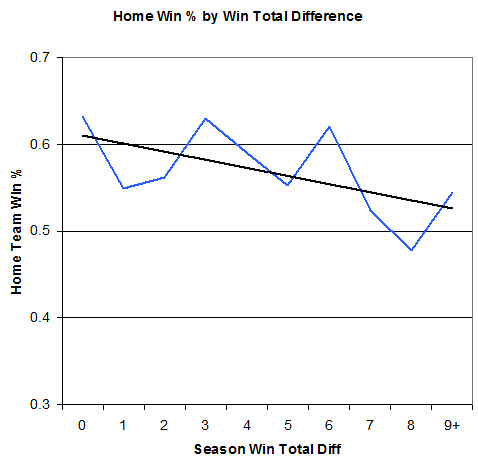 In my recent post about NBA and NFL home advantage I made the contention that the importance of home field advantage (HFA) increases when opponents are more evenly matched. I said this based on the results of this study, which looked at the importance of various factors in the playoffs. Because playoff games are relatively rare and offer a small sample size, I decided to look at regular season games that featured two playoff-caliber opponents in order to expand the data set. I noticed that home field advantage appeared stronger in games that featured "good vs good" teams or "bad vs. bad" teams compared to games that featured "good vs bad" match-ups.
In my recent post about NBA and NFL home advantage I made the contention that the importance of home field advantage (HFA) increases when opponents are more evenly matched. I said this based on the results of this study, which looked at the importance of various factors in the playoffs. Because playoff games are relatively rare and offer a small sample size, I decided to look at regular season games that featured two playoff-caliber opponents in order to expand the data set. I noticed that home field advantage appeared stronger in games that featured "good vs good" teams or "bad vs. bad" teams compared to games that featured "good vs bad" match-ups.
Some commenters were understandably skeptical, so I dug a little deeper. I looked at all NFL regular season games from the 2002 through 2006 seasons (a total of 1280 games) and it turns out the effect appears real but not extremely consistent.
The graph below plots home team win percentage against season win total difference. For example, if a game featured a team that would eventually go 12-4 against a team that would end up 8-8, the season win total difference would be 4. As the gap between the relative strength of the opponents increases, HFA shrinks. For teams that end up with the same record, the home field advantage is relatively strong at 63% compared to an overall average of 57%.
Admittedly, the effect is not consistently smooth, which suggests there is a good deal of randomness involved. But the trend is fairly clear and it is consistent with what we observe in playoff games, not only in the NFL but the NBA as well.
On the other hand, if we accept the smoothed line, HFA ranges from 61% for evenly matched games down to 53% for mismatches. On the surface 8% doesn't seem very strong, but think of it this way: the effect of HFA ranges from +11% to +3%, a several-fold difference.
NFL Home Field Advantage and Team Strength
By
Brian Burke
published on 6/24/2008
in
home field advantage,
modeling,
research,
reviews
Subscribe to:
Post Comments (Atom)








Awesome!
This agrees very well with my theory that the HFA expressed as a win % between equally matched teams is constant and that the only reason it seems to decrease with differences among teams is a natural consequence of the logistic assumption.
Use the win difference % as a proxy for team rating (theoretical win % against an average opponent) and plug the team ratings into the logistic formula:
HFA*R1*(1-R2)/(HFA*R1*(1-R2)+(1-HFA)*R2*(1-R1))
for each team at home and average the result. What you get is a curved line that would fit your data very well! (I'm e-mailing you my spreadsheet to make this clearer.)
Got the spreadsheet. The equation fits the data extremely well. If I understand you, you're confirming that HFA is really the same for all games, but that it manifests itself as apparently more important the closer the opponents are in ability.
Or in other words, HFA stays constant, but we detect it more frequently the closer in ability the two opponents are.
Very well put. Not only that, you mathematically proved it! Brilliant.
My question is what do you mean "home field advantage is more important for evenly matched teams"?
As the first comment discussed (and as you pointed out yourself to some extent) this curves is a natural consequence of a 2-3 point home field advantage (HFA). For a game with unevenly matched teams, then 2-3 points is not important and the better team will almost always win whether at home or away. But in a game with a evenly matched teams, then getting a few extra points for the home team will be quite valuable.
So I would ask if the 2-3 point HFA is as consistent in for games between evenly matched teams as it is for teams that are poorly matched. Rather than looking at (Winning %) vs (season win total diff), look at (margin of victory) vs (something like the "Simple Rating System" predictions). Then you can see if team get more than a 2-3 point bonus in close games and less than a 2-3 point bonus in lopsided games.
Tim-
My language is quite sloppy. You're right HFA itself isn't stronger with two evenly matched opponents. HFA has the same strength of effect no matter the opponent. It becomes more decisive when teams are close in ability.
I did what you suggested and looked at margin of victory across all types of match-ups. It's *extremely* linear at about 2.5-3.0 points regardless of the match-up type.